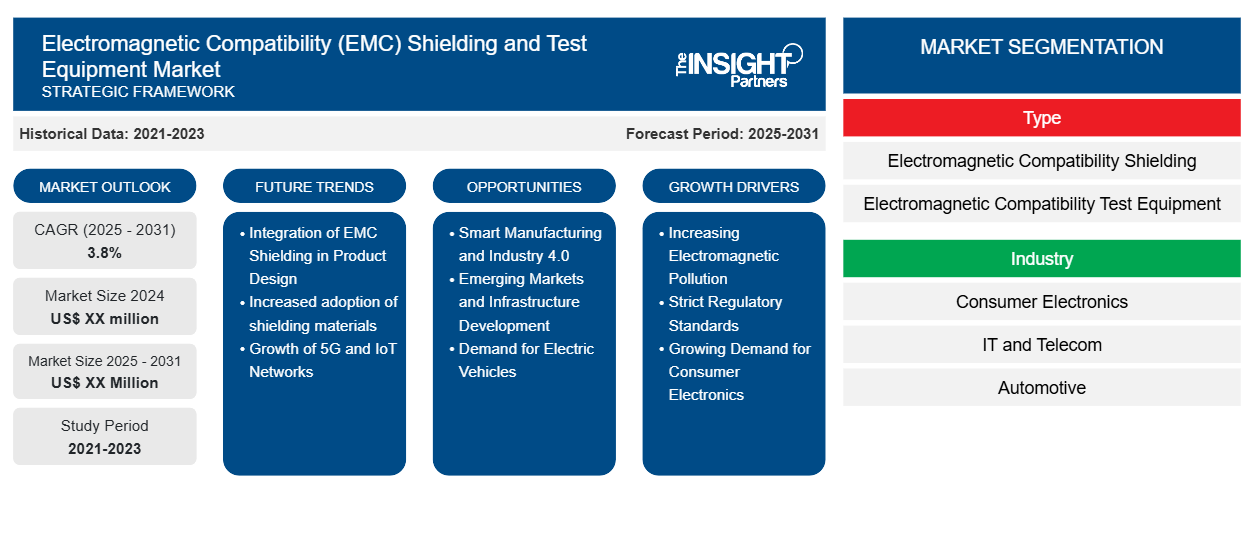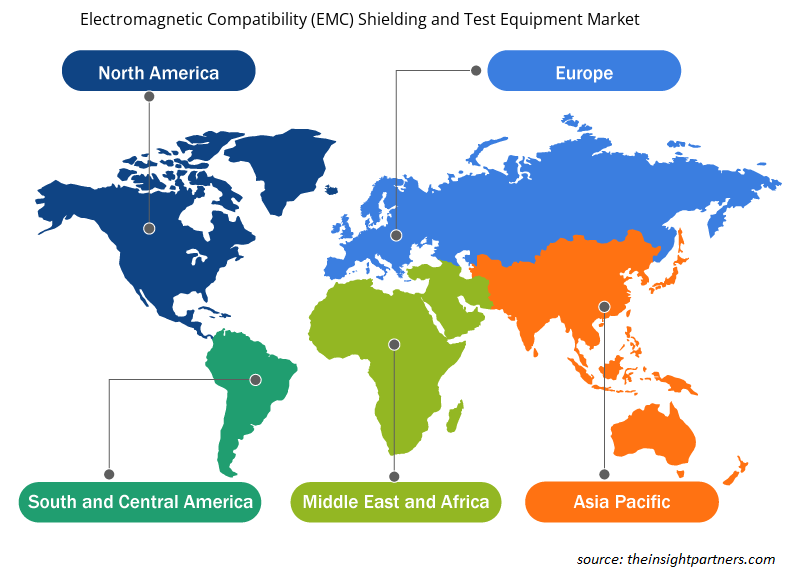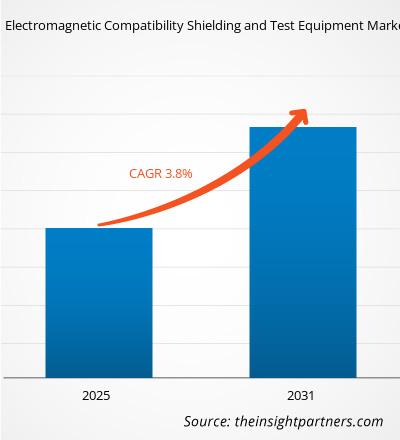Le marché des équipements de test et de blindage de compatibilité électromagnétique ( CEM ) devrait enregistrer un TCAC de 3,8 % de 2023 à 2031, avec une taille de marché passant de XX millions USD en 2023 à XX millions USD d'ici 2031.
Le rapport sur le marché des équipements de test et de blindage de compatibilité électromagnétique ( CEM ) couvre l'analyse par type ( blindage de compatibilité électromagnétique ( CEM ), équipement de test de compatibilité électromagnétique ( CEM )) ; industrie (électronique grand public, informatique et télécommunications, automobile, santé, gouvernement et défense, laboratoires, autres). L'analyse globale est ensuite décomposée au niveau régional et par principaux pays. Le rapport offre la valeur en USD pour l'analyse et les segments ci-dessus.
Objectif du rapport
Le rapport sur le marché des équipements de test et de blindage de compatibilité électromagnétique ( CEM ) de The Insight Partners vise à décrire le paysage actuel et la croissance future, les principaux facteurs moteurs, les défis et les opportunités. Cela fournira des informations à diverses parties prenantes commerciales, telles que :
- Fournisseurs/fabricants de technologie : pour comprendre l’évolution de la dynamique du marché et connaître les opportunités de croissance potentielles, leur permettant de prendre des décisions stratégiques éclairées.
- Investisseurs : Effectuer une analyse complète des tendances concernant le taux de croissance du marché, les projections financières du marché et les opportunités qui existent tout au long de la chaîne de valeur.
- Organismes de réglementation : Réglementer les politiques et surveiller les activités du marché dans le but de minimiser les abus, de préserver la confiance des investisseurs et de maintenir l’intégrité et la stabilité du marché.
Segmentation du marché des équipements de test et de blindage de compatibilité électromagnétique ( CEM )
Taper
- Blindage de compatibilité électromagnétique
- Equipement de test de compatibilité électromagnétique
Industrie
- Électronique grand public
- Informatique et Télécom
- Automobile
- Soins de santé
- Gouvernement et défense
- Laboratoires
- Autres
Personnalisez ce rapport en fonction de vos besoins
Vous bénéficierez d'une personnalisation gratuite de n'importe quel rapport, y compris de certaines parties de ce rapport, d'une analyse au niveau des pays, d'un pack de données Excel, ainsi que de superbes offres et réductions pour les start-ups et les universités.
Marché des équipements de test et de blindage de compatibilité électromagnétique ( CEM ) : informations stratégiques

- Obtenez les principales tendances clés du marché de ce rapport.Cet échantillon GRATUIT comprendra une analyse de données, allant des tendances du marché aux estimations et prévisions.
Facteurs de croissance du marché des équipements de test et de blindage de compatibilité électromagnétique (CEM)
- Augmentation de la pollution électromagnétique : avec la prolifération des appareils sans fil, des systèmes de communication et de l'électronique grand public, les EMI sont devenues un problème critique, ce qui nécessite un blindage CEM et des équipements de test pour garantir la fonctionnalité et la conformité.
- Normes réglementaires strictes : les gouvernements et les organisations internationales, telles que la FCC, la CE et l'ISO, appliquent des réglementations CEM strictes pour les appareils et systèmes électroniques, créant une demande de solutions de blindage et d'équipements de test pour répondre à la conformité.
- Demande croissante en électronique grand public : la demande croissante en électronique grand public, comme les smartphones, les appareils portables et les appareils électroménagers, nécessite un blindage CEM avancé pour éviter les dysfonctionnements des appareils dus aux interférences électromagnétiques.
- Industrie automobile et aérospatiale : Il s'agit du développement de véhicules et d'avions de haute technologie équipés de systèmes de conduite autonome, d'avionique, qui nécessitent un blindage et des tests CEM pour que les composants électroniques fonctionnent correctement.
Tendances futures du marché des équipements de test et de blindage de compatibilité électromagnétique (CEM)
- Intégration du blindage CEM dans la conception des produits : En un mot, l'intégration du blindage CEM dans la conception des produits améliorerait les performances des produits à mesure que les entreprises intègrent le blindage CEM à un stade plus avancé dans l'électronique grand public pour réduire les délais de mise sur le marché.
- Adoption accrue de matériaux de blindage : les matériaux de blindage tels que les revêtements conducteurs, les composites métalliques et les matériaux à base de carbone sont de plus en plus adoptés pour le blindage CEM en raison de leur grande efficacité et de leur légèreté.
- Croissance des réseaux 5G et IoT : cela augmente le nombre de sources d’interférences électromagnétiques, ce qui nécessite un développement supplémentaire des solutions de blindage et de test.
Opportunités de marché en matière de blindage et d'équipements de test de compatibilité électromagnétique (CEM)
- Fabrication intelligente et Industrie 4.0 : L'application croissante de l'automatisation, de la robotique et de la communication sans fil dans les installations industrielles a conduit à une demande croissante de blindage CEM efficace pour éviter les interférences qui pourraient avoir un impact sur les performances des systèmes critiques dans les usines de fabrication.
- Marchés émergents et développement des infrastructures : Alors que les processus d’industrialisation et d’urbanisation se poursuivent dans des régions telles que l’Asie-Pacifique, l’Amérique latine et l’Afrique, la demande d’équipements de test et de blindage CEM devrait augmenter dans des secteurs tels que les télécommunications, l’automobile et la fabrication.
- Demande de véhicules électriques : L'opportunité potentielle dans le secteur automobile pour les solutions de blindage CEM liées au besoin croissant de véhicules électriques et de véhicules autonomes comprend l'électronique de puissance, les capteurs et les unités de contrôle à l'intérieur du véhicule.
Aperçu régional du marché des équipements de test et de blindage de compatibilité électromagnétique (CEM)
Les tendances et facteurs régionaux influençant le marché des équipements de test et de blindage de compatibilité électromagnétique (CEM) tout au long de la période de prévision ont été expliqués en détail par les analystes d’Insight Partners. Cette section traite également des segments et de la géographie du marché des équipements de test et de blindage de compatibilité électromagnétique (CEM) en Amérique du Nord, en Europe, en Asie-Pacifique, au Moyen-Orient et en Afrique, ainsi qu’en Amérique du Sud et en Amérique centrale.

- Obtenez les données régionales spécifiques au marché des équipements de test et de blindage de compatibilité électromagnétique (CEM)
Portée du rapport sur le marché des équipements de test et de blindage de compatibilité électromagnétique (CEM)
| Attribut de rapport | Détails |
|---|---|
| Taille du marché en 2023 | XX millions de dollars américains |
| Taille du marché d'ici 2031 | XX millions de dollars américains |
| Taux de croissance annuel composé mondial (2023-2031) | 3,8% |
| Données historiques | 2021-2022 |
| Période de prévision | 2024-2031 |
| Segments couverts | Par type
|
| Régions et pays couverts | Amérique du Nord
|
| Leaders du marché et profils d'entreprises clés |
|
Densité des acteurs du marché des équipements de test et de blindage de compatibilité électromagnétique (CEM) : comprendre son impact sur la dynamique commerciale
Le marché des équipements de test et de blindage de compatibilité électromagnétique (CEM) connaît une croissance rapide, tirée par la demande croissante des utilisateurs finaux en raison de facteurs tels que l'évolution des préférences des consommateurs, les avancées technologiques et une plus grande sensibilisation aux avantages du produit. À mesure que la demande augmente, les entreprises élargissent leurs offres, innovent pour répondre aux besoins des consommateurs et capitalisent sur les tendances émergentes, ce qui alimente davantage la croissance du marché.
La densité des acteurs du marché fait référence à la répartition des entreprises ou des sociétés opérant sur un marché ou un secteur particulier. Elle indique le nombre de concurrents (acteurs du marché) présents sur un marché donné par rapport à sa taille ou à sa valeur marchande totale.
Les principales entreprises opérant sur le marché des équipements de test et de blindage de compatibilité électromagnétique (CEM) sont :
- 3M
- AMETEK, Inc.
- Société Com-Power
- ETS Lindgren
- TECHNOLOGIES HV, INC.
Avis de non-responsabilité : les sociétés répertoriées ci-dessus ne sont pas classées dans un ordre particulier.

- Obtenez un aperçu des principaux acteurs du marché des équipements de test et de blindage de compatibilité électromagnétique (CEM)
Principaux arguments de vente
- Couverture complète : Le rapport couvre de manière exhaustive l’analyse des produits, des services, des types et des utilisateurs finaux du marché des équipements de test et de blindage de compatibilité électromagnétique (CEM), offrant un paysage holistique.
- Analyse d’experts : Le rapport est compilé sur la base d’une compréhension approfondie des experts et analystes du secteur.
- Informations à jour : Le rapport garantit la pertinence commerciale en raison de sa couverture des informations récentes et des tendances des données.
- Options de personnalisation : ce rapport peut être personnalisé pour répondre aux exigences spécifiques du client et s'adapter parfaitement aux stratégies commerciales.
Le rapport de recherche sur le marché des équipements de test et de blindage de compatibilité électromagnétique (CEM) peut donc aider à ouvrir la voie au décodage et à la compréhension du scénario de l’industrie et des perspectives de croissance. Bien qu’il puisse y avoir quelques préoccupations valables, les avantages globaux de ce rapport ont tendance à l’emporter sur les inconvénients.
- Analyse historique (2 ans), année de base, prévision (7 ans) avec TCAC
- Analyse PEST et SWOT
- Taille du marché Valeur / Volume - Mondial, Régional, Pays
- Industrie et paysage concurrentiel
- Ensemble de données Excel
Rapports récents
Témoignages
Raison d'acheter
- Prise de décision éclairée
- Compréhension de la dynamique du marché
- Analyse concurrentielle
- Connaissances clients
- Prévisions de marché
- Atténuation des risques
- Planification stratégique
- Justification des investissements
- Identification des marchés émergents
- Amélioration des stratégies marketing
- Amélioration de l'efficacité opérationnelle
- Alignement sur les tendances réglementaires




















 Obtenez un échantillon gratuit pour - Marché des équipements de test et de blindage de compatibilité électromagnétique (CEM)
Obtenez un échantillon gratuit pour - Marché des équipements de test et de blindage de compatibilité électromagnétique (CEM)